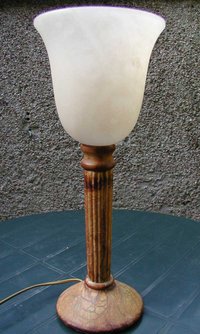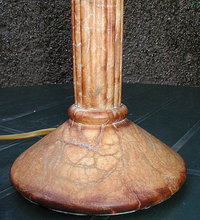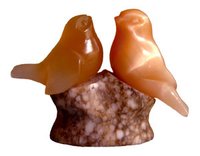Alabaster
|
|
Alabaster (sometimes called satin spar) is a name applied to varieties of two distinct minerals: gypsum (a hydrous sulfate of calcium) and the calcite (a carbonate of calcium). The former is the alabaster of the present day; the latter is generally the alabaster of the ancients.
The two kinds are readily distinguished from each other by their relative hardnesses. The gypsum kind is so soft as to be readily scratched by a finger-nail (hardness 1.5 to 2), while the calcite kind is too hard to be scratched in this way (hardness 3), though it does yield readily to a knife. Moreover, the calcite alabaster, being a carbonate, effervesces on being touched with hydrochloric acid, whereas the gypsum alabaster, when so treated, remains practically unaffected.
Calcite Alabaster
This substance, the "alabaster" of scripture, is often termed Oriental alabaster, since the early examples came from the Far East. The Greek name alabastrites is said to be derived from the town of Alabastron, in Egypt, where the stone was quarried, but the locality probably owed its name to the mineral; the origin of the mineral-name is obscure, and it has been suggested that it may have had an Arabic origin. This "Oriental" alabaster was highly esteemed for making small perfume-bottles or ointment vases called alabastra, and this has been conjectured to be a possible source of the name. Alabaster was also employed in Egypt for Canopic jars and various other sacred and sepulchral objects. A splendid sarcophagus, sculptured in a single block of translucent calcite alabaster from Alabastron, is in the Soane Museum, London. This was discovered by Giovanni Belzoni in 1817 in the tomb of Seti I near Thebes. It was purchased by Sir John Soane, having previously been offered to the British Museum.
When cut in thin sheets, alabaster is translucent enough to be used for small windows, and has been used so in medieval churches, especially in Italy. Large alabaster sheets are used extensively in the Cathedral of Our Lady of the Angels (dedicated 2002) of the Los Angeles (California) Archdiocese. The cathedral incorporates special cooling to prevent the panes from overheating and turning opaque.
Calcite alabaster is either a stalagmitic deposit, from the floor and walls of limestone caverns, or a kind of travertine, similarly deposited in springs of calcareous water. Its deposition in successive layers gives rise to the banded appearance that the marble often shows on cross-section, whence it is known as onyx-marble or alabaster-onyx, or sometimes simply as onyx – a term which should, however, be restricted to siliceous minerals. Egyptian alabaster has been extensively worked near Suez and near Assiut; there are many ancient quarries in the hills overlooking the plain of Tell el Amarna. The Algerian onyx-marble has been largely quarried in the province of Oran. In Mexico, there are famous deposits of a delicate green variety at La Pedrara, in the district of Tecali, near Puebla. Onyx-marble occurs also in the district of Tehuacán and at several localities in California, Arizona, Utah, Colorado and Virginia.
Gypsum Alabaster
In the present day, when the term "alabaster" is used without any qualification, it invariably means a fine-grained variety of gypsum. This mineral, or alabaster proper, occurs in England in the Keuper marls of the Midlands, especially at Chellaston in Derbyshire, at Fauld in Staffordshire and near Newark in Nottinghamshire. At all these localities it has been extensively worked. It is also found, though in subordinate quantity, at Watchet in Somerset, near Penarth in Glamorganshire, and elsewhere. In Cumbria it occurs largely in the New Red rocks, but at a lower geological horizon. The alabaster of Nottinghamshire and Derbyshire is found in thick nodular beds or "floors" in spheroidal masses known as "balls" or "bowls," and in smaller lenticular masses termed "cakes." At Chellaston, where the alabaster is known as "Patrick," it has been worked into ornaments under the name of "Derbyshire spar" – a term more properly applied to fluorspar.
The finer kinds of alabaster are largely employed as an ornamental stone, especially for ecclesiastical decoration and for the rails of staircases and halls. Its softness enables it to be readily carved into elaborate forms, but its solubility in water renders it inapplicable to outdoor work. The purest alabaster is a snow-white material of fine tiniforni grain, but it is often associated with an oxide of iron, which produces brown clouding and veining in the stone. The coarser varieties of alabaster are converted by calcination into plaster of Paris, whence they are sometimes known as "plaster stone."
On the continent of Europe, the centre of the alabaster trade is Florence, Italy. Tuscan alabaster occurs in nodular masses embedded in limestone, interstratified with marls of Miocene and Pliocene age. The mineral is largely worked by means of underground galleries,in the district of Volterra. Several varieties are recognized – veined, spotted, clouded, agatiform, and others. The finest kind, obtained principally from Castellina, is sent to Florence for figure-sculpture, while the common kinds are carved at a very cheap rate locally into vases, clock-cases and various ornamental objects, in which a large trade is carried on, especially in Florence, Pisa and Leghorn.
In order to diminish the translucency of the alabaster and to produce an opacity suggestive of true marble, the statues are immersed in a bath of water and gradually heated nearly to the boiling-point – an operation requiring great care, for if the temperature is not carefully regulated, the stone acquires a dead-white, chalky appearance. The effect of heating appears to be a partial dehydration of the gypsum. If properly treated, it very closely resembles true marble and is known as marmo di Castellina. It should be noted that sulphate of lime (gypsum) was used also by the ancients, and was employed, for instance, in Assyrian sculpture, so that some of the ancient alabaster is identical with the modern stone.
Alabaster may be stained by digesting it, after being heated in various pigmentary solutions. In this way a good imitation of coral has been produced (alabaster coral).
Black Alabaster is a rare form of the gypsum-based mineral found in only three veins in the world, one each in Oklahoma (USA), Italy and China.
Alabaster Caverns State Park, near Freedom, Oklahoma is home to a natural gypsum cave in which much of the gypsum is in the form of alabaster. There are several types of alabaster found at the site, including pink, white, and the rare black alabaster.
See also
- Alabaster is also a city in Alabama, USA. See: Alabaster, Alabama
- Alabaster is also a township in Michigan, USA. See: Alabaster Township, Michigande:Alabaster



